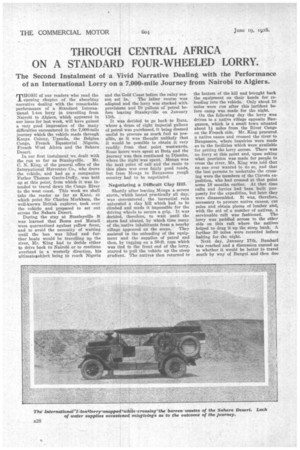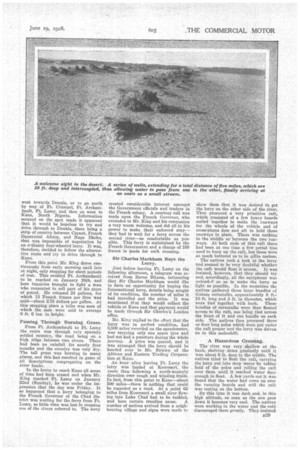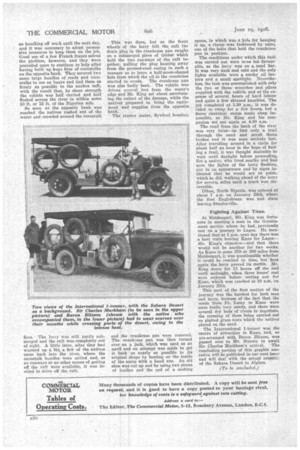THROUGH CENTRAL AFRICA ON A STANDARD FOUR-WHEELED LORRY.
Page 54

Page 55

Page 56

If you've noticed an error in this article please click here to report it so we can fix it.
The Second Instalment of a Vivid Narrative Dealing with the Performance of an International Lorry on a 7,000-mile Journey from Nairobi to Algiers.
THOSE of our readers who read the opening chaptet •of the absorbing narrative dealing with the remarkable performance of a Standard International 1-ton lorry in travelling from Nairobi to Algiers, which appeared in our issue for last week, will have gained a very good impression of the many difficulties encountered in the 7,000-mile journey which the vehicle made through Kenya Colony, Uganda, the Belgian Congo, French Equatorial Nigeria, French West Africa and the Sahara Desert.
In our first instalment we dealt with the run so far as Stanleyville. Mr. C. N. King, of the general office of the International Harvester Co., who drove the vehicle, and had as a companion Father Thomas Gavin-Duffy, was held up at this point, from which it was intended to travel down the Congo River to the west coast. This week we shall take the reader as far as Kano, at which point Sir Charles Markham, the well-known British explorer, took over the vehicle and prepared to set out across the Sahara Desert.
During the stay at Stanleyville it was learned that Boma and Matadi were quarantined against yellow fever, and to avoid the necessity of waiting until the ban was lifted and further boats would be travelling up the river, Mr. 'King had to decide either to drive back to Nairobi or to continue overland in a westerly direction, his ultimatetobject being to reach Nigeria
and the Gold Coast before the rainy sea son set in. The latter course was adopted and the lorry was stocked with provisions and 70 gallons of petrol before leaving Stanleyville on January 12th. ,
It was decided to go back to Both, where a drum of eight imperial gallons of petrol was purchased, it being deemed useful to procure as much fuel as possible, as it was thought unlikely that it would be possible to obtain lt. very readily from that point westwards. Some hours were spent at Buta and the journey was then continued to Djamba, where the night was spent. Monga was the next point of call and the route to this place was over fairly good roads, but from Monga to Bangassou rough country had to be negotiated.
Negotiating a Diflictdt Clay Hill.
Shortly after leaving Monga a severe storm, which lasted practically all day, was • encountered ; the torrential rain saturated a clay hill which had to be climbed and made it impossible for the driving wheels, to secure a grip. It was decided, therefore, to wait until the storm had abated, by which time many of the, native inhabitants from a nearby village appeared on the scene. They assisted in the unloading of the equipment and the supplies of petrol and then, by tugging on a 50-ft. rope which was tied to the front end of the lorry, started to pull the vehicle up the steep gradient. The natives then returned to the bottom of the hill and brought back the equipment on their heads for reloading into the vehicle. Only about 10 miles were run after this incident before camp was made for the night.
On the following day the lorry was driven to a native village opposite Bangassou, which is a small town situated about 14 miles from the River Congo on the French side. Mr. King procured a native canoe and crossed the river to Bangasson where inquiries were made as to the facilities which were available for getting the lorry across. There was no ferry at this point and, upon asking what provision was made for people to cross the river, Mr. King was told that no one ever wanted to do so, and that the last persons to undertake the crossing were the members of the Citroiin expedition, who had crossed at that point some 18 months earlier. At that time rafts and ferries had been built purposely for the expedition, but later they were disassembled. It was, therefore, necessary to procure native canoes, cut poles and obtain pieces of lumber and with the aid of a number of natives, a
serviceable raft wasfashioned. The lorry was paddled across to the other side on this raft where the natives helped to drag it up the steep bank. A further 30 miles were recorded before halting for the night.
Next day, January 17th, Bambari was reached and a discussion ensued as to whether it would be better to travel south by way of Bangui and then due west towards Douala, or to go north by way of Ft. Crampel, Ft. Archambault, Ft. Lamy, and then on west to Kano, North Nigeria. Information secured on the spot made it apparent that it would be hopeless to try and drive through to Douala. there being a strip of country between Carnet, French Equatorial Africa, and Naga Eboko, that was impossible of negotiation by an o-dinary four-wheeled lorry. It was, therefore, decided to follow the alternative route and try to drive through to Kano.
From this point Mr. King drove continuously from early morning until late at night, only stopping for short periods of rest. This enabled Ft. Archambault to be reached on January 20th, and here inquiries brought to light a man who consented to sell part of his store of petrol. He released 24 gallons, for which 13 French francs per litre was paid—about 2.75 dollars per gallon. At this stopping place a tribe was seen of which the men were said to average 6 ft. 6 ins, in height.
Passing Through Burning Grass.
From Ft. Archambault to Ft. Lamy the route was through very sparsely settled country, the road being on a high ridge between two rivers. There had been no rainfall for nearly four months and the country was very dry. The tall grass was burning in many places, and this had resulted in game of all descriptions congregating on the river banks.
In the hurry to reach Kano all sense of time had been erased and when Mr. King reached Ft. Lamy on January 22nd (Sunday), he was under the impression that the day was Friday. It so happened that a lorry belonging to the French Governor of the Chad district was waiting for the ferry from rt. Lamy, so little time was lost in crossing one of the rivers referred to. The lorry
created considerable interest amongst the Government officials and traders in the French colony. A. courtesy call was made upon the French Governor, who extended to Mr. King and his companion a very warm welcome, and did all in his power to make their enforced staythey had to wait for a ferry across the second river—as comfortable as possible. This ferry is maintained by the French Government and a charge of 100 francs is made for each crossing.
Sir Charles Markham Buys the Lorry.
Just before leaving Ft. Lamy on the • following afternoon, a telegram was received from Baron Blixem, intimating that Sir Charles Markham would _like to have an opportunity for buying the. International lorry, details being sought of its condition, the number of miles it had travelled and the price. It was mentioned that they would collect the vehicle at Kano and that payment would be made through Sir Charles's London office.
Mr. King replied to the effect that the lorry was in perfect condition, had 3,500 miles recorded on the speedometer, was carrying only one spare tyre and had not had a puncture during the whole journey. A price was quoted, and it was arranged that the lorry should be handed over to Mr. Strewn of the African and Eastern Trading Corporation at Kano. .
An hour after leaving Pt. Lamy the lorry was landed 'at Koursseri, . the route then following a north-westerly direction over rough and winding trails. In fact, from this point to Kano—about 500 miles—there is nothing that could be regarded as a road. At a point 65 miles from Koursseri a small river flowing into Lake Chad had to be tackled, and here certain troubles arose. A number of natives arrived from a neighbouring Tillage and signs were made to show them that it was desired to get the lorry on the other side of the river. They procured a very primitive raft, which consisted of a few heavy boards nailed together to make the runways for the wheels of the vehicle and of cross-pieces fore and aft to hold these runways in place. There was nothing in the middle or between the two runways. At both ends of this raft there had been at one time a few petrol tins used to buoy up the raft, but these were so much battered as to be quite useless.
• The natives took a look at the lorry and seemed to be very doubtful whether the raft would float it across. It was insisted, however, that they should try and, accordingly, all the equipment was niiloakd so as to make the lorry as light as possible. In the meantime the natives gathered three large bundles of Guinea cornstalks, approximately 8 ft.10 ft. long and 3 ft. in diameter, which were tied together with bark. These bundles of cornstalks were then floated across to the raft, one being tied across the front of it and one bundle on each side. The natives then procured three or four long poles which were put under the raft proper and the lorry was driven on to this makeshift.
A Hazardous Crossing.
The river was very shallow at the bank, shelving down gradually until it was about 6 ft. deep in the middle. The natives tried to float the raft, carrying the lorry out into deep water by taking hold of the poles and rolling the raft over them until it reached water deep enough to float. A few yards out it was found that the water had come up over the running boards and still the raft was resting on the bottom.
By this time it was dark and, in this high altitude, so soon as the sun goes down it becomes very cool. The natives were working in the water and the cold discouraged them grsatly. They insisted
on knocking off wesek until the next day, and it was necessary to adopt persuasive measures to keep them on the job. Good use of a few French francs solved the problem, however, and they were prevailed upon to continue to help after having built up huge fires of cornstalks on the opposite bank. They secured two more large bundles of reeds and cornstalks to use as buoys and tied them as firmly as possible to the sunken raft, with the result that, by sheer strength the vehicle was half carried and half floated across the river to within some 10 ft. or 15 ft. of the Nigerian side.
So soon as the opposite bank was reached the natives rushed out of the water and crowded around the cornstalk
fires. 'The lorry was still partly submerged and the raft was completely out of sight. A. little later, after they had warmed up a bit, a few of the natives came hack into the river, where the cornstalk bundles were untied and, as 110 runways or no other means of getting off the raft were available, it was decided to drive off the raft.
This was done, but as the front wheels of the lorry left the raft the drain plug in the crankcase pan caught on a submerged piece of timber which held the two runways of the raft together, pulling the plug housing away from the pressed-steel casing in such a manner as to leave a half-moon-shaped hole from which the cii in the crankcase started to exude. The crankcase pan was also badly bent. 'The vehicle was driven several feet from the water's edge and Mr. King set about ascertaining the extent of the damage, while the natives prepared to bring the equipment and supplies from the opposite bank.
The starter motor, flywheel housing, and the crankcase pan were removed. The crankcase pan was then turned over on a jack, which was used as an anvil and an attempt was made to get it back as nearly as possible to its original shape by heating on the inside of the sump with a hand axe. An old shoe was cut up and by using two pieces of leather and the end of a cooking spoon, in which was a hole for hanging it up, a clamp was fashioned by using one of the bolts that held the crankcase pan in position.
The conditions under which this tasl. was carried out were Ilene too favourable, as the lorry was on a sand bar. It was very dark and cold and the only lights available were a smoky oil lantern and a small spotlight. Nevertheless, the task wa,s accomplished with only the two or three wrenches and pliers supplied with the vehicle and at the exPense of several hours of hard labour and quite a few skinned knuckles. The job completed at 1.30 p.m., it was decided to camp for a few hours, but a fierce electrical storm made sleep impossible, so Mr. King and his companion set out again at 4.30 a.m.
The road from the bank of the river was very faint—in fact only a trail through the sand and scrub thorn bushes and it was soon entirely lost. After travelling around in a circle for about half an hour in the hope of finding a trail, it was thought desirable to wait until daylight before proceeding, liht a native, who lived nearby and had seen the lights of the lorry flashing, put in an appearance and by signs indicated that he would act as guide, which he did, walking ahead of the lorry for several miles until a track was discernible.
Dikoa, North Nigeria, was entered at about 7 am, on January 24th, where the first Englishman was met since leaving Stanleyville,
Fighting Against Time.
At Maidougari, Mr. King was fortunate in meeting a man in the Government service whom he had. previously met on .a journey to Lagos. He mentioned that at 1 p.m. next day there was a boat train leaving Kano for Lagos—. Mr. King's objective—and that . there would not be another for two weeks. As Kano is some 370 or 380 miles from Maidougari, it was questionable whether it could be reached in time, but here again the lorry proved its mettle. Mr. King drove for 13 hours off the reel ' nntil midnight, when three hours' rest were enjoyed before setting out for Kano, which was reached at 10 a.m. on January 25th.
This part of the first section of the journey was the hardest for both men and lorry, because of the fact that the roads from Ft. Lamy to Kano were mere trails, very sandy, and there were several dry beds of rivers to negotiate, the crossing of them being carried. out on plaited grass mats which the natives placed on the sand.
The International 1-tonner was the centre of attraction in Kano, and, as pre-arranged with Baron Blixem, was passed over to Mr. Strewn to await Sir Charles hlarkham's arrival. The concluding portion of this graphic narrative will be published in our next issue and will deal with the actual crossing of the Sahara Desert to Algiers.
(To be concluded.)




















































































































